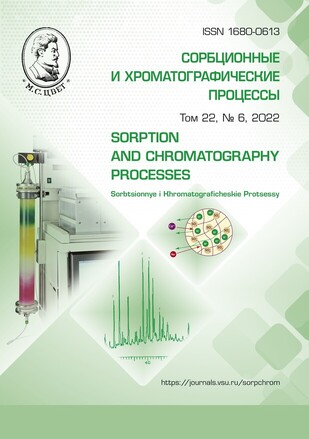Using ion-exchange chromatography to purify glutathione reductase from the liver of rats with paracetamol-induced liver disease to investigate some catalytic properties
Abstract
The purpose of the work was to study the activity of glutathione reductase (GR, EC 1.8.1.7.) in case of paracetamol-induced liver disease (PLD) and to isolate and purify the enzyme using gel filtration and ion-exchange chromatography to evaluate some catalytic and regulatory properties. PLD was simulated by a single oral administration of acetaminophen to white male laboratory Wistar rats (Rattus norvegicus). The dosage was 1000 mg/kg of rat’s weight in 1 cm3 of paraffinic oil. Animals of the control group were given paraffinic oil. The activity of GR was determined spectrophotometrically at a wavelength of 340 nm. The purification of the enzyme from the liver of rats was carried out using fractionation with ammonium sulphate, gel filtration through Sephadex G-25, and ion exchange chromatography through DEAE-cellulose. The total amount of protein in the samples was determined using the BCA protein assay kit. As a result, GR was obtained from the liver of rats with PLD with a purification degree of 33.3. Using the Lineweaver–Burk method of double inverse coordinates, it was shown that the administration of paracetamol to rats was accompanied by an increase in the affinity of the enzyme for NADPH. The addition to the reaction medium of isocitrate and glucose-6-phosphate, which are substrates of enzymes supplying NADPH for the reduction of oxidised glutathione, contributed to a more pronounced activation of GR from the liver of animals with PLD as compared to the control group. The observed increase in GR activity with the addition of isocitrate and glucose-6-phosphate was apparently associated with an additional activating effect of these compounds on the enzyme, which occurred under the conditions of oxidation of reduced glutathione in the case of PLD. At the same time, the introduction of citrate into the spectrophotometry media led to a more significant decrease in GR activity relative to the control values. The observed changes in the enzyme properties could be associated with antioxidant properties of the citrate, which reduced the intensity of free radical oxidation in the case of PLD. Therefore, fractionation, gel filtration, and ion-exchange chromatography on DEAE-cellulose were used to obtain a purified GR preparation from the liver of rats with PLD which demonstrated an increase in affinity for NADPH and a change in the activity regulation under the action of citrate, isocitrate, and glucose-6-phosphate.
Downloads
References
Korenskaya E.G., Paramonova O.V. Medicinal liver damage is one of the important problems in a comorbid patient. Consilium Medicum. 2019; 21(8): 78-83. https://doi.org/10.26442/20751753.2019.8.190355
Kong L.Z., Chandimali N, Han Y.H., Lee D.H., Kim J.S., Kim S.U., Kim T.D., Jeong D.K., Sun H.N., Lee D.S., Kwon T. Pathogenesis, Early Diagnosis, and Therapeutic Management of Alcoholic Liver Disease. International Journal of Molecular Sciences. 2019; 20(11): 2712-2733. https://doi.org/10.3390/ijms20112712
Cichoż-Lach H., Michalak A. Oxida-tive stress as a crucial factor in liver diseases. World J Gastroenterol. 2014; 20(25): 8082-8091. https://doi.org/10.3748/wjg.v20.i25.8082
Newsome P.N., Plevris J.N., Nelson L.J., Hayes P.C. Animal models of fulminant hepatic failure: a critical evaluation Liver Transpl. 2000; 6: 21-31. https://doi.org/10.1002/lt.500060110
Polson J., Lee W.M., American Asso-ciation for the Study of Liver Disease. AASLD position paper: the management of acute liver failure. Hepatology. 2015: 41(5): 1179-1197. https://doi.org/10.3748/wjg.v20.i25.8082
Wang Z., Hao W., Hu J. Maltol improves APAPinduced hepatotoxicity by inhibit-ing oxidative stress and inflammation response via NF-κB and PI3K/Akt signal pathways. Antioxidants. 2019; 8(9): 395-398. https://doi.org/10.3390/antiox8090395
Hasanuzzaman M., Bhuyan, M.H.M.B., Anee, T.I., Parvin, K., Nahar, K., Mahmud, J.A., Fujita, M. Regulation of Ascorbate-Glutathione Pathway in Mitigating Oxidative Damage in Plants under Abiotic Stress. Antioxidants. 2019; 8: 384. https://doi.org/10.3390/antiox8090384
Mitchel J.R., Jallow D.G., Potter W.Z., Acetaminopheninduced hepatic necrosisss. Protective role of glutathione. J. Pharmacol. Exp. Ther. 2003; 187: 211-217. https://doi.org/10.3390/antiox8090395
Popov S.S., Agarkov A.A., Kryl'skiy E.D., Shul'gin K.K., Popova T.N., Safonova O.A. The activity of glutathione reductase un-der liver pathologies and enzyme purification by ion-exchange chromatography for the catalytic properties study. Sorbtsionnye I Khromatograficheskie Protsessy. 2018; 7(1): 168-175.
Jönsson B.A.G., Ermund A., Andersson D.A, Björk H, Alexander J.P. Conversion of acetaminophen to the bioactive N-acylphenolamine AM404 via fatty acid amide hydrolase-dependent arachidonic acid conjugation in the nervous system. J Biol Chem. 2015; 280: 31405-31412. https://doi.org/10.1074/jbc.M501489200
Graham G.G., Davies M.J., Day R.O., Mohamudally A., Scott K.F. The modern pharmacology of paracetamol: therapeutic ac-tions, mechanism of action, metabolism, toxicity and recent pharmacological findings. In-flammopharmacology. 2013; 21: 201-232. https://doi.org/10.1007/s10787-013-0172-x
Tran R.T., Yang J., Ameer G.A. Citrate-Based Biomaterials and Their Applications in Regenerative Engineering. An-nu Rev Mater Res. 2015; 45: 277-310. https://doi.org/10.1146/annurev-matsci-070214-020815
Akram M. Citric Acid Cycle and Role of its Intermediates in Metabolism. Cell Biochem Biophys. 2014; 68: 475-478. https://doi.org/10.1007/s12013-013-9750-1







